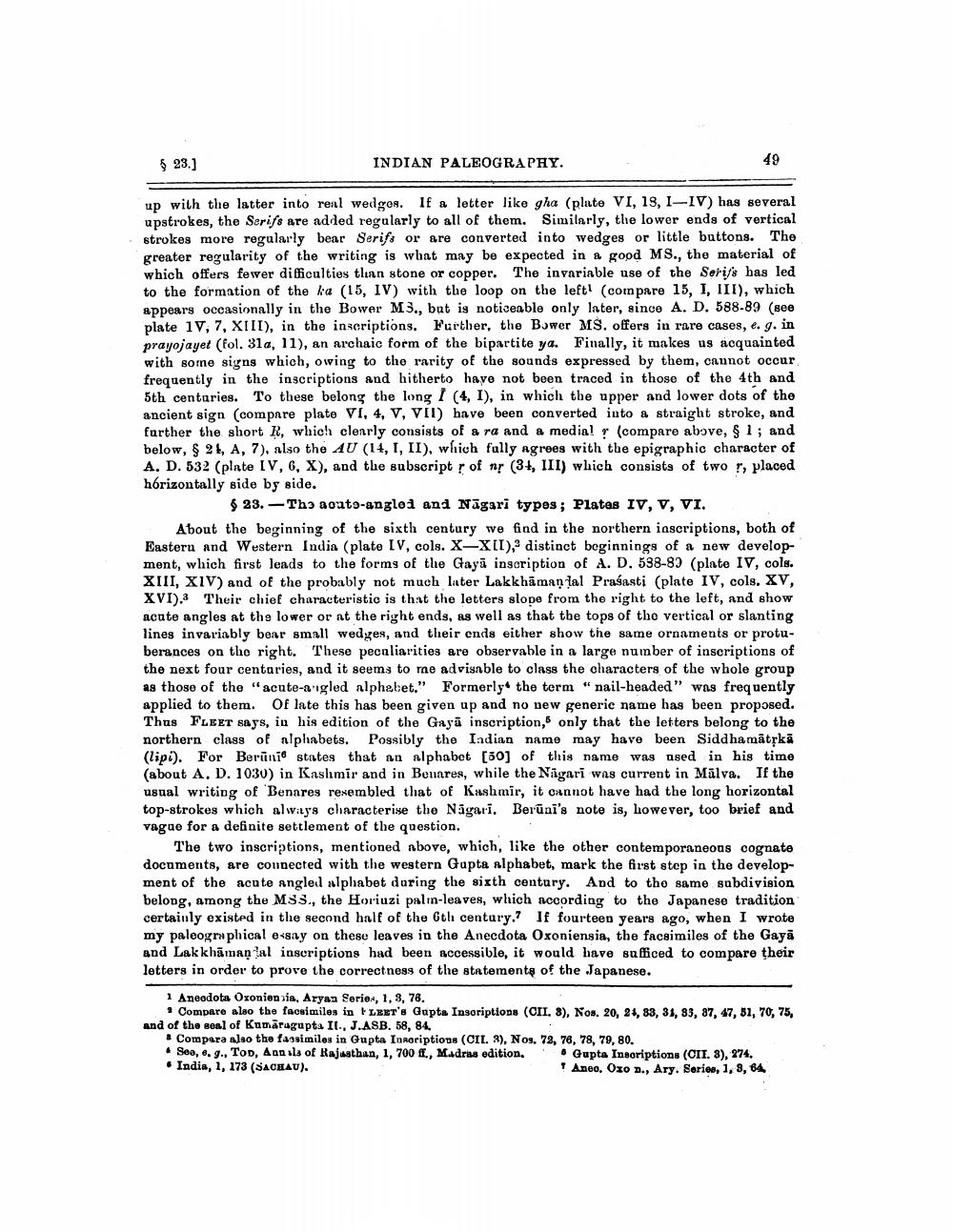________________
23.)
INDIAN PALEOGRAPHY.
up with the latter into real wedges. If a letter like gha (plate VI, 13, 1-IV) has several upstrokes, the Serifs are added regularly to all of them. Similarly, the lower ends of vertical strokes more regularly bear Serifs or are converted into wedges or little buttong. The greater regularity of the writing is what may be expected in a good MS., the material of which offers fewer difficulties tlian stone or copper. The invariable use of the Serifs bas led to the formation of the ka (15, IV) with the loop on the left! (compare 15, I, III), which appears occasionally in the Bower M3., but is noticeable only later, since A. D. 588-89 (see plate 17, 7, XIII), in the inscriptions. Further, the Bower MS. offers in rare cases, e. g. in prayojayet (fol. 31a, 11), an archaic form of the bipartite ya. Finally, it makes us acquainted with some signs which, owing to the rarity of the sounds expressed by them, cannot occur frequently in the inscriptions and hitherto have not been traced in those of the 4th and 5th centuries. To these belong the long I (4, I), in which the upper and lower dots of the ancient sign (compare plate VI, 4, V, VII) have been converted into a straight stroke, and further the short R, which clearly consists of a ra and a media!! (compare above, $1; and below, $ 21, A, 7), also the AU (14, I, II), which fully agrees with the epigraphic character of A. D. 532 (plate IV, 6, X), and the subscript of nr (3+, III) which consists of two !, placed horizontally side by side.
$23. -Tha aouts-angloi and Nāgari types; Plates IV, V, VI. About the beginning of the sixth century we find in the northern inscriptions, both of Eastern and Western India (plate IV, cols. X-XII), distinct beginnings of a new development, which first leads to the forms of the Gayà inscription of A. D. 538-89 (plate IV, cols. XIII, XIV) and of the probably not much later Lakkhāmanlal Prasasti (plate IV, cols. XV, XVI). Their chief characteristic is that the letters slope from the right to the left, and show acate angles at the lower or at the right ends, as well as that the tops of the vertical or slanting lines invariably bear small wedges, and their ends either show the same ornaments or protuberances on the right. These peculiarities are observable in a large number of inscriptions of the next four centaries, and it seems to me advisable to class the characters of the whole group as those of the "acute-a igled alphabet." Formerly the term "nail-headed" was frequently applied to them. Of late this has been given up and no new generic name has been proposed. Thus FLEET says, in his edition of the Gayà inscription, only that the letters belong to the northern class of alphabets. Possibly the Indian name may have been Siddhamātskā (lipi). For Berūnio states that an alphabet [50] of this name was ased in his time (about A, D. 1030) in Kashmir and in Benares, while the Nāgari was current in Mālva. If the usual writing of Benares resembled that of Kashmir, it cannot have had the long horizontal top-strokes which always characterise the Nāgari. Berūni's note is, however, too brief and vague for a definite settlement of the question.
The two inscriptions, mentioned above, which, like the other contemporaneous cognato documents, are connected with the western Gupta alphabet, mark the first step in the development of the acute angled alphabet during the sixth century. And to the same subdivision belong, among the M33., the Horiuzi palin-leaves, which according to the Japanese tradition certainly existed in the second half of the 6th century.? If fourteen years ago, when I wrote my paleographical esny on these leaves in the Anecdota Oxoniensia, the facsimiles of the Gayā and Lakkhāmaņlal inscriptions had been accessible, it would have sufficed to compare their letters in order to prove the correctness of the statements of the Japanese.
1 Aneodota Oxoniensia, Aryan Series, 1, 3, 78.
• Compare also the facsimiles in TLEXT's Gupta Inscriptions (CII, 8), Nos. 20, 21, 83, 31, 83, 87, 47, 51, 70, 75, and of the seal of Kumārugupta II., J.ASB. 58, 84.
• Compera also the fassimiles in Gupta Insoriptions (CIL. 3), Nos, 72, 76, 78, 79, 80. . See, e. 9., TOD, Agnals of Rajasthan, 1, 700 ff., Madras edition, ' Gupta Insoriptions (CII. 3), 274. • India, 1, 173 (ACHAU).
Aneo, Ozo D., Ary. Series, 1, 3, 64,




